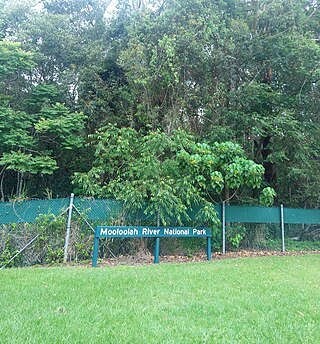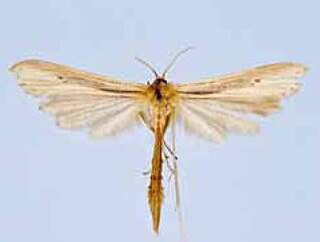
Yuraygir is a national park in New South Wales, Australia, located 482 km (300 mi) northeast of Sydney. It was created in 1980, a result of the merger and enlargement of two national parks, Angourie and Red Rock National Parks, both of which had been established in 1975. At the time of its establishment in 1980, the park was fragmented, and parcels of land were bought over the following two decades to unite segments into a more contiguous protected area. Sometimes these acquisitions required protracted negotiations with land owners.

The Mooloolah River National Park is a nationally protected area located on the Sunshine Coast, Queensland. It covers an area of 830.9 hectares and is bordered by the Mooloolah River to the east, Claymore and Dixon Roads to the west, and the Lower Mooloolah River Environmental Reserve to the south. It is bisected by the Sunshine Motorway with the northern, 161.93 hectare component of the Park being a later addition. The Park was initially vacant crown land prior to national park designation in 1960. Surrounding land uses include livestock grazing, urban development and the campus of the University of the Sunshine Coast. It is the second largest mainland park on the coastal lowlands in South East Queensland after Noosa National Park and represents an example of low-lying coastal floodplain distinctive of the region.

The Pterophoridae or plume moths are a family of Lepidoptera with unusually modified wings, giving them the shape of a narrow winged airplane. Though they belong to the Apoditrysia like the larger moths and the butterflies, unlike these they are tiny and were formerly included among the assemblage called "microlepidoptera".

Baccharis is a genus of perennials and shrubs in the aster family (Asteraceae). They are commonly known as baccharises but sometimes referred to as "brooms", because many members have small thin leaves resembling the true brooms. They are not at all related to these however, but belong to an entirely different lineage of eudicots. B. halimifolia is commonly known as "groundsel bush", however true groundsels are found in the genus Senecio.

Baccharis halimifolia is a North American species of shrubs in the family Asteraceae. It is native to Nova Scotia, the eastern and southern United States, eastern Mexico, the Bahamas, and Cuba.

The Cochylini are a tribe of tortrix moths. It used to be classified as the subfamily Cochylinae.

Baccharis sarothroides is a North American species of flowering shrub known by the common names broom baccharis, desertbroom, greasewood, rosin-bush and groundsel in English and "escoba amarga" or "romerillo" in Spanish. This is a spreading, woody shrub usually sticky with glandular secretions along the primarily leafless green stems. The small, thick leaves are a few centimeters long and are absent much of the year, giving the shrub a spindly, twiggy appearance. It flowers abundantly with tiny green blooms on separate male and female plants.
Groundsel is a common name for several plants and may refer to:

Breton National Wildlife Refuge is located in southeastern Louisiana in the offshore Breton Islands and Chandeleur Islands. It is located in the Gulf of Mexico and is accessible only by boat. The refuge was established in 1904 through executive order of President Theodore Roosevelt and is the second-oldest refuge in the National Wildlife Refuge System.

Lorita is a genus of moths belonging to the subfamily Tortricinae of the family Tortricidae.
Bucculatrix ivella is a moth of the family Bucculatricidae. It was described in 1900 by August Busck. It is native to North America, but has been introduced to Queensland, Australia.

Lorita scarificata, the chrysanthemum flower borer, is a moth of the family Tortricidae. It is native to North America and is an introduced species in Hawaii.

Hellinsia balanotes, the baccharis borer, is a moth of the family Pterophoridae which is native to Guatemala, northern Mexico, and the United States including Arizona, Texas, Florida, Mississippi, South Carolina and Maryland, but has been introduced to Australia for the control of Baccharis halimifolia. The species was first described by Edward Meyrick in 1908.
Sparganothis tunicana is a species of moth of the family Tortricidae. It is found in North America in California, Washington, Oregon, Utah, Idaho and British Columbia.
Lorita insulicola is a species of moth of the family Tortricidae. It is found on the British Virgin Islands and Guadeloupe.
Lorita lepidulana is a species of moth of the family Tortricidae. It is found in Puerto Rico, Cuba and on St. Thomas in the U.S. Virgin Islands.
Argyrotaenia loxonephes is a species of moth of the family Tortricidae. It is found in Argentina.
Argyrotaenia sphaleropa is a species of moth of the family Tortricidae. It is found in South America, where it has been recorded from Colombia, Bolivia, Brazil, Peru, Uruguay and Argentina.
Aristotelia ivae is a moth of the family Gelechiidae. It was described by August Busck in 1900. It is found in North America, where it has been recorded from Florida and Georgia.
Prochoerodes truxaliata is a species of geometrid moth in the family Geometridae.









